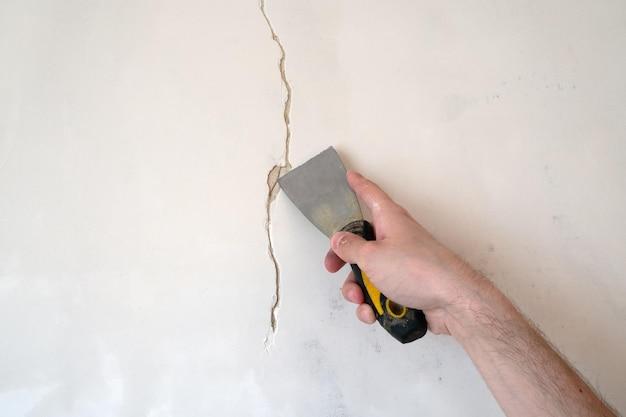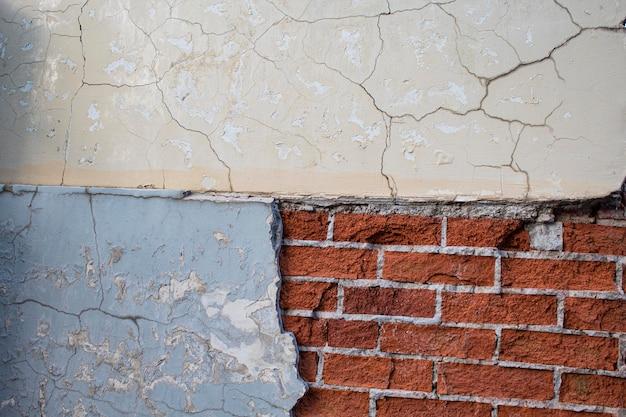Plaster cracks can be a common occurrence in homes, especially as buildings settle over time. These cracks can be unsightly and may also indicate underlying structural issues. So, what can you do to address these pesky cracks? One popular option is using caulk to fill them. But is caulk suitable for plaster cracks? In this blog post, we will delve into the world of caulking and plaster cracks, exploring some common questions and providing you with the information you need to know.
We will discuss the causes of plaster cracks, the difference between caulk and filler, and whether or not you should be worried about hairline cracks in plaster. Additionally, we will explore various methods to stop plaster from cracking and examine the best products for filling and repairing cracks in plaster. Finally, we will give you step-by-step instructions on how to caulk deep cracks in your plaster walls and ceilings.
So, if you’re dealing with plaster cracks and wondering if caulk is the solution, keep reading to find answers to all your questions. Let’s dive in and discover the best ways to address those unsightly cracks and restore the pristine beauty of your walls and ceilings!
Can You Use Caulk On Plaster Cracks
Understanding the Quirks of Plaster Cracks
Plaster cracks can be quite the sneaky troublemakers, showing up uninvited and wreaking havoc on our walls. Whether it’s a hairline crack or a more noticeable crevice, these little buggers can be quite the eyesore. But fear not, dear reader, for there may be a simple solution to your plaster woes: caulk!
The Versatility of Caulk
Caulk, that magical substance that contractors and DIY enthusiasts swear by, has a multitude of uses. While it is commonly used for sealing gaps and joints around windows and doors, caulk can also come to the rescue when dealing with plaster cracks. Yes, you heard that right! Caulk, with its flexible and adhesive properties, can work its magic on those pesky crevices, providing a quick fix for your plaster problems.
Choosing the Right Caulk
Before you go on a caulk shopping spree, it’s important to understand that not all caulks are created equal. When it comes to fixing plaster cracks, you’ll want to opt for a flexible caulk that can withstand the natural movement of plaster. Look for caulks labeled as “paintable” to ensure that you can easily camouflage the repaired cracks later on.
Step-by-Step Guide for Using Caulk on Plaster Cracks
-
Prepare the crack: Clean the crack thoroughly by removing any loose plaster or debris. This will ensure that the caulk adheres properly to the surface.
-
Apply the caulk: Load your caulk gun with the chosen caulk and cut the tip at a 45-degree angle for a controlled flow. Slowly squeeze out the caulk into the crack, making sure to fill it completely. Smooth the caulk with a putty knife or a wet finger for a seamless finish.
-
Let it dry: Give the caulk some time to dry and cure. This typically takes around 24 hours, but it’s always wise to check the product instructions for specific drying times.
-
Paint over it: Once the caulk is dry, you can paint over it to match the surrounding wall. Remember to use a paint that is compatible with the caulk you’ve chosen for the best results.
The Benefits of Caulk
Using caulk on plaster cracks offers several benefits. Not only does it provide a quick and cost-effective fix, but it also helps prevent further damage by sealing the crack and preventing moisture from seeping in. Additionally, caulk’s flexibility allows it to expand and contract with the movement of the plaster, reducing the likelihood of future cracks reappearing.
So next time you find yourself face-to-face with a plaster crack, reach for that trusty caulk gun and give it a go. With the right caulk and a little bit of patience, you’ll have those cracks fixed up in no time. Happy caulking, my fellow plaster problem solvers!
Note: This blog post is for informational purposes only and should not be construed as professional advice. If you have extensive or severe plaster damage, it’s recommended to consult a professional contractor for proper repairs.
FAQ: Can You Use Caulk On Plaster Cracks
Whether you’re a homeowner looking to tackle some minor repairs or a DIY enthusiast taking on a home improvement project, understanding how to deal with plaster cracks is essential. One popular question that comes up time and time again is whether or not it’s appropriate to use caulk to fill plaster cracks. In this FAQ-style subsection, we’ll address some common queries about using caulk on plaster cracks and provide you with the information you need to make the best decision for your project.
What is the best sealant for concrete cracks?
When it comes to dealing with concrete cracks, it’s best to use a sealant specifically designed for this purpose. Look for sealants labeled as “concrete crack sealant” or “concrete repair sealant.” These sealants are formulated to bond effectively with concrete and provide long-lasting protection against further cracking.
Are hairline cracks in plaster normal?
Hairline cracks in plaster are relatively common and often not a cause for concern. Over time, as your house settles and experiences temperature fluctuations, small cracks can develop. However, if you notice widening or recurring cracks, it may be a sign of underlying structural issues that require further attention.
What is the difference between caulk and filler?
Caulk and filler serve different purposes when it comes to crack repair. Caulk is flexible and is best suited for sealing gaps and joints that are subject to movement, such as where two different materials meet. On the other hand, filler is used to fill and smooth out cracks, providing a solid surface for painting or further treatment.
Why do my plaster walls keep cracking?
Plaster walls can crack for several reasons, including shifting foundations, moisture damage, temperature changes, or simply the natural settling of your home. It’s important to identify the underlying cause of the cracking to prevent further damage and ensure a successful repair.
What causes hairline cracks in plaster?
Hairline cracks in plaster can occur due to a variety of reasons, including normal settling of the building, moisture fluctuations, or even poor application during the plastering process. It’s worth noting that hairline cracks are usually superficial and can be repaired easily with the right techniques.
Can you paint over hairline plaster cracks?
Yes, you can paint over hairline plaster cracks once they have been properly repaired. It’s important to use a high-quality primer and ensure that the repaired area is smooth and even before applying paint. This will help to hide the repaired crack and provide a seamless finish.
How big of a gap can you fill with caulk?
Caulk is ideal for filling small to medium-sized gaps. Typically, caulk can successfully fill gaps up to ¼ inch in width. For larger gaps or deep cracks, it’s advisable to use a combination of filler and caulk to achieve the best results.
How can you tell if a crack is structural?
Determining whether a crack is structural or not can be challenging for non-professionals. However, some signs may indicate a structural issue, such as cracks that are wider than 1/8 inch, diagonal cracks, or cracks accompanied by other signs of foundation problems. If you suspect a structural issue, it’s crucial to consult a professional before attempting any repairs.
How do you stop plaster from cracking?
To minimize the risk of plaster cracking, it’s essential to address any underlying issues and ensure proper installation techniques. Adequate preparation of the surface, using the right mix of plaster, and allowing sufficient curing time can significantly reduce the chances of cracks appearing. Additionally, maintaining consistent humidity levels in your home can help prevent plaster from drying out and cracking.
Can you fill cracks with caulk?
Yes, you can fill cracks with caulk, but it’s important to consider the size and type of crack. Caulk is suitable for hairline cracks or small gaps where movement between materials is expected. However, for larger cracks or deeper gaps, it’s best to use a combination of filler and caulk for a durable and long-lasting repair.
What caulk does not crack?
There are various types of caulks available, but some high-quality options are specifically designed to resist cracking. Look for caulks labeled as “flexible” or “crack-resistant” for the best results. It’s always a good idea to read product reviews and consult with professionals to ensure you’re choosing the right caulk for your specific application.
How do you fix deep cracks in plaster walls?
Deep cracks in plaster walls require a multi-step approach for effective repair. Start by widening the crack with a utility knife and removing any loose plaster. Apply a suitable filler to fill the crack, following the manufacturer’s instructions. Once the filler has dried and hardened, sand it down to achieve a smooth finish. Finally, apply a primer and paint to complete the repair.
Should I be worried about hairline cracks in plaster?
Hairline cracks in plaster are typically a normal part of a building’s settling process and are not usually a cause for concern. However, it’s essential to monitor these cracks over time. If they widen or recur despite repairs, it may be a sign of an underlying issue that requires professional attention.
How do you repair a hairline crack in a plaster ceiling?
To repair a hairline crack in a plaster ceiling, start by widening the crack slightly with a utility knife. Next, apply a thin layer of filler into the crack and smooth it out with a putty knife. Once the filler has dried, sand it down to achieve a seamless finish. If necessary, repeat the process until the crack is no longer visible. Finally, paint the repaired area to match the rest of the ceiling.
What is the best filler for cracks in plaster?
When it comes to filling cracks in plaster, a gypsum-based filler is often the best choice. These fillers are easy to work with, provide good adhesion to plaster surfaces, and offer excellent durability. Look for fillers specifically labeled for use on plaster for the best results.
Can I paint over caulk?
Yes, you can paint over caulk once it has fully cured. It’s important to choose a paint that is compatible with the caulk and allows for proper adhesion. Be sure to follow the manufacturer’s instructions for both the caulk and paint to achieve the best outcome.
How do you caulk deep cracks?
To caulk deep cracks, start by cleaning the crack and removing any loose debris. Fill the crack partially with a suitable filler, leaving enough space to apply the caulk. Once the filler has dried, apply caulk on top, making sure to press it into the crack for proper adhesion. Smooth out the caulk with a putty knife and allow it to cure according to the manufacturer’s instructions.
How large of a crack can you caulk?
Caulk is suitable for small to medium-sized cracks up to ¼ inch in width. If the crack exceeds this width or is deeper, it’s advisable to use a combination of filler and caulk to achieve a more robust and long-lasting repair.
Should I use caulk or filler?
The choice between caulk and filler depends on the nature of the crack and its location. Fillers are best for static cracks where stability is crucial, while caulk is ideal for cracks or gaps subject to movement. In some cases, a combination of filler and caulk may be necessary to achieve the most effective repair.
With this comprehensive FAQ-style section, you now have all the information you need to confidently tackle plaster cracks and decide whether using caulk is the right choice for your particular project. Remember to assess the size, type, and underlying cause of the cracks before proceeding. Happy repairing!

